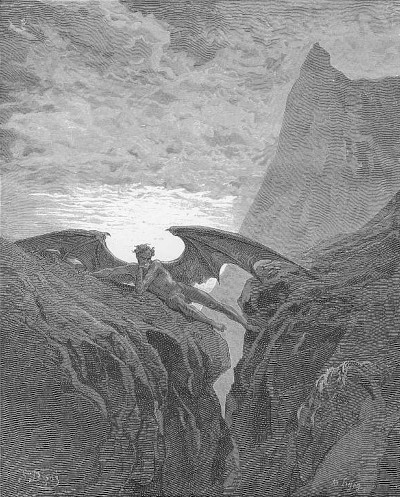This plate is part of the Paradise Lost series by Gustave Doré which brought to life the famous poem by 17th-century English poet John Milton. Doré work totalled 50 plates and the edition was published in 1866.
Now Night her Course began... is the title of this illustration and is a direct quote from the poem itself. The composition features a winged figure in the foreground, balancing on some rocky cliffs. The character is darkened to the same degree as the environment that surrounds it, and there is then a taller mountain in the distance. To left in the background we then see a bright light which brings some lighter tones to the piece. The poem itself, Paradise Lost, was completed by the poet around two centuries earlier and ran into ten books. The content refers to the Fall of Man and is broadly based around that religious theme. The French illustrator's work on this particular plate was one of fifty items that he contributed for the edition that appeared two hundred years later and is marked as plate number 26, meaning it would likely have appeared roughly around the half way point of the book. This may sound like a large project, but in other series, Gustave Doré would create several hundreds of drawings and they could often feature more detail than is found within the likes of Plate no 26, Book VI, line 406, '...Now Night her Course began...'
This design would have been turned into an engraving by one of the artist's assistants before then being printed into the book itself at around the same time. Doré had a strong relationship with a number of British and French publishers across the 1860s and would regularly be asked to provide illustrations for projects such as this. Many focused on popular literature from the past two centuries, but there were also older sources such as Dante's Divine Comedy and even The Bible. This artist's approach was heavily connected to the Romanticist movement and that seemed to suit topics such as this. He would attempt to achieve similar levels of fame in other mediums but could never quite manage it, eventually having to settle for being classed as a specialist illustrator with some talents in other disciplines. One can also find examples in his career of where he might tackle the same content in different mediums, such as his painting and illustration of Little Red Riding Hood.
The artist worked tirelessly throughout the 1860s to produce a huge number of illustrations and also to oversee their transition into completed publications. It was an exciting time within the UK and his native France, with levels of literacy on the increase and many more people now able to buy and read books. Publishers sought to create the finest examples possible by bringing in big names from the art world and at that time, Doré was considered the best book illustrator around. He had more offers of work than he could reasonably deliver, even with all of his hired help, and so would have to turn some commissions down. His assistants became more and more involved as his workload expanded, with even some drawings being completed by his assistants but then signed by the master himself. On top of all this, he would also branch out into other mediums in order to keep his creativity as refreshed as possible.




